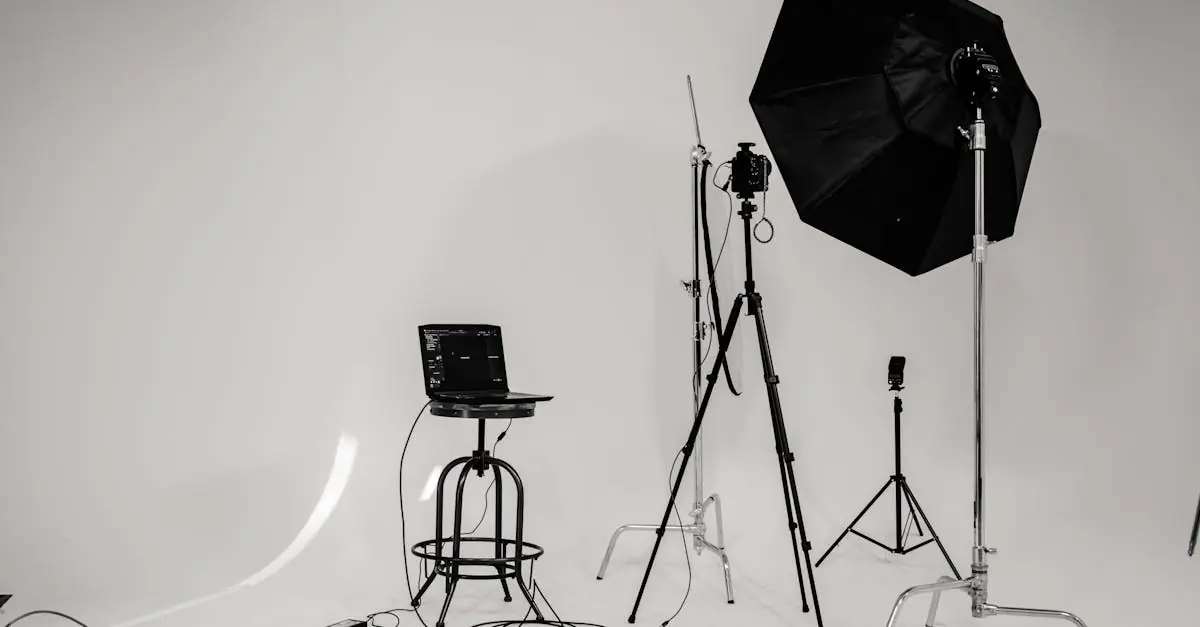Table of Contents
ToggleWhen it comes to capturing the perfect shot on an iPhone, lighting can make or break the moment. Imagine snapping a pic of your friend mid-laugh only to find it’s darker than a cave at midnight. Fear not! With just a few tweaks, that iPhone camera flash can go from zero to hero.
Understanding iPhone Camera Flash
The iPhone camera flash serves as a valuable tool for enhancing photos taken in low-light conditions. It functions by emitting a brief burst of light to illuminate subjects, reducing the risk of dark or blurry images. Users can adjust the flash settings in the iPhone Camera app to align with their shooting needs.
Different flash modes exist to cater to various situations. Auto mode activates the flash automatically in low-light environments, while On mode keeps it engaged regardless of lighting. Off mode disables the flash completely. Each setting impacts the final image quality, so selecting the proper mode is crucial for achieving optimal results.
One essential aspect of using the iPhone flash involves understanding its limitations. Flash cannot illuminate distant subjects effectively, as its range is typically limited to around 10 feet (approximately 3 meters). For subjects beyond this distance, other lighting options may be necessary. Additionally, strong flash usage can create harsh shadows and unflattering skin tones.
Timing matters too. Coordinating the flash with the moment of capture ensures subjects appear well-lit. In some cases, using the flash as a fill light while also taking advantage of available ambient light enhances overall image quality. This technique helps to soften shadows and provide a more natural appearance.
Experimenting with the flash in different settings can yield valuable insights. Observing how it interacts with various light conditions helps users become more adept at capturing striking images. Understanding the iPhone camera flash’s capabilities and limitations enables photographers to utilize this tool effectively for improved photography results.
Types of iPhone Camera Flash
Different types of camera flash enhance photography on iPhones by providing essential lighting in varying conditions. Understanding these options helps users choose the best method for their specific needs.
LED Flash
LED flash serves as the primary light source for iPhone photography. This flash emits a brief burst of strong light, effectively illuminating subjects in low-light conditions. Users appreciate its ability to reduce motion blur and enhance details. The LED flash operates optimally within a range of approximately 10 feet, ensuring subjects remain well-lit. Despite its advantages, the LED flash can create harsh shadows or unflattering skin tones if not used carefully. Experimenting with timing and positioning helps users capture balanced images, maximizing the LED flash’s potential.
Screen Flash
Screen flash utilizes the iPhone’s display to provide illumination when taking selfies or in dark environments. This functionality enables the screen to act as a soft light source, providing a more flattering and natural look. It works particularly well for close-range shots, enhancing facial features without harsh contrasts. Users can activate it by selecting the front camera and turning the flash on in the Camera app settings. Screen flash is ideal for situations where traditional flash might be too intense or distracting. By using both the LED flash and screen flash as tools, photographers can achieve various effects and improve image quality.
Steps to Make iPhone Camera Flash
Optimizing the iPhone camera flash enhances photo quality in low-light conditions. Follow these steps for effective use.
Accessing Camera Settings
Users start by opening the Camera app. From there, they can tap the flash icon located in the upper left corner. This icon displays the current flash mode. It’s crucial to ensure that the camera is in photo mode, as other modes might not display the flash options. Selecting different modes offers flexibility in lighting scenarios. Familiarity with these settings allows for quick adjustments.
Enabling Flash Options
Three flash modes exist—Auto, On, and Off. In Auto mode, the camera decides when to use the flash based on the lighting conditions. For consistently well-lit images, users opt for the On setting, ensuring the flash activates with every photo. Off mode disables the flash completely, useful for bright environments. Understanding these options ensures appropriate lighting for various shooting conditions, enhancing overall image quality.
Adjusting Flash Brightness
While iPhones do not offer direct flash brightness adjustments, good composition techniques can compensate. Users can move closer to subjects to capture more light. Softening shadows can also help achieve better results by angling the camera for optimal light use. Experimenting with distance and camera angle aids in utilizing available light effectively. Testing different settings in various environments reveals how the flash interacts with surroundings, leading to improved photographic outcomes.
Tips for Effective Use of iPhone Camera Flash
Adjusting the iPhone camera flash can significantly enhance photo quality. Utilize the flash in various modes based on the environment. For low-light settings, turning on the flash can help illuminate subjects effectively. Engaging the Auto mode allows the camera to decide when to activate the flash, making it convenient for quick shots.
Experimenting with different angles and distances from the subject offers more creative results. Moving closer can reduce shadows, ensuring well-lit photos while still capturing detail. Understanding how the iPhone’s LED flash interacts with surroundings is essential for optimal lighting.
In dark environments, using the screen flash for selfies provides a softer glow that flatters skin tones. Taking a few test shots can help photographers see how the flash impacts the overall tonal quality. When using the flash, timing plays a vital role; capturing the moment as the flash fires can prevent unsightly shadows.
Consider blending flash with ambient light for a more balanced exposure. This combination often results in more natural-looking images. Avoid shooting subjects with reflective surfaces directly in front of the flash, as this can cause glare.
Clearing any obstacles between the flash and the subject also makes a difference. Soft filtering techniques can further improve flash photos, reducing harsh brightness and maintaining clarity. Regular practice with the flash settings enhances knowledge of its capabilities, leading to better photography outcomes.
Troubleshooting Common Flash Issues
Flash problems can occur unexpectedly while using the iPhone camera. Users often encounter a situation where the flash doesn’t activate when expected. First, they should check if the flash is enabled in the Camera app. Adjusting the flash settings to ‘On’ can ensure it activates for photos.
Occasionally, the flash might work intermittently. Inspecting the iPhone’s LED flash for any obstruction is important. Debris on the lens can interfere with functionality. Cleaning the lens gently can resolve many of these issues quickly.
In some cases, the flash might create harsh lighting. To reduce this effect, consider bouncing the flash off nearby surfaces. Reflecting light can create a softer illumination, improving overall image quality. Experimenting with angles will allow users to find optimal lighting conditions.
If flash stays on continuously, restarting the camera app can initially resolve the glitch. Closing the app and reopening it often resets minor bugs. Users may also discover that resetting all settings under the iPhone’s settings menu can clear persistent problems.
When flash emits a weak light, checking battery levels is essential. A low battery may affect flash performance. Ensuring the device is charged ensures that all features operate at full capacity.
Users might notice that the flash works but produces odd colors in photos. Adjusting the white balance setting can counteract this issue. Balancing light tones improves color accuracy in images.
Steps to troubleshoot include testing each mode individually. Switching between Auto, On, and Off can reveal if the flash requires recalibration. Taking multiple photos under varying conditions will help determine the most effective solutions.
Mastering the iPhone camera flash can significantly elevate photography skills. By understanding how to adjust flash settings and utilizing both LED and screen flash effectively, users can enhance their images in low-light conditions. Experimentation with angles and distances plays a crucial role in achieving the desired results.
Additionally, incorporating ambient light and avoiding direct reflections can create balanced and flattering photos. Regular practice and troubleshooting common issues will lead to better outcomes over time. With these tips in hand, photographers can confidently capture stunning images, regardless of lighting challenges.




